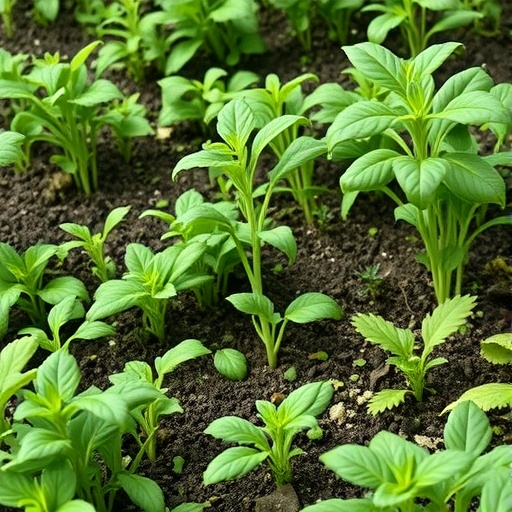In recent years, the progression of agricultural industrialization has brought significant economic benefits to rural areas, particularly in places like Shandong Province, China. Within these evolving landscapes, however, there lurks a potentially insidious threat: the accumulation of potentially toxic elements (PTEs) that could pose grave ecological and health risks. A new study examines the implications of these contaminants, shedding light on both source-specific risks and the steps that need to be taken to mitigate them. The study, conducted by a team of researchers including Xia, Zhang, and Zhang, breaks new ground in understanding the intricate dynamics between agricultural practices and toxic element exposure.
As industrial farming expands, so too does the reliance on various chemical inputs, including fertilizers and pesticides. These substances, while improving crop yields, can harbor hazardous constituents. The researchers focused on identifying specific sources of PTEs in agricultural soil, water, and crops within their target area. By employing a detailed analytical approach, the team was able to discern the unique footprints of different pollution sources—tethering the ecological situation back to human activity. This convergence of agriculture and industrialization raises serious questions about long-term sustainability.
One of the most alarming findings of this research is the specific types of PTEs that were detected in elevated concentrations throughout the studied town. Elements such as lead, cadmium, and arsenic were among those identified, each possessing unique pathways of toxicity. The team utilized rigorous sampling methods to ensure that their results reflect real-world conditions. The correlation between these elements and agricultural practices underscores an urgent need to rethink how farming communities engage with their environment.
The investigators took a multi-faceted approach to study the distribution of PTEs, employing geographic information systems (GIS) alongside chemical analyses. This methodology not only enriched the findings but also provided a visual map of contamination, pinpointing areas most at risk. By delineating these hotspots, the research team aimed to facilitate targeted interventions that could alleviate public health concerns. The implications of such mapping extend beyond scientific inquiry; they serve as a call to action for policymakers to create more restrictive guidelines regarding contaminant management in agricultural settings.
The health ramifications of exposure to these toxic elements are severe. Chronic exposure is associated with various health issues, including neurodevelopmental disorders in children, respiratory problems, and potential carcinogenic effects. Communities living in close proximity to contaminated sites often suffer the most. The researchers highlighted the need for rigorous health assessments among the exposed populations to identify the spectrum of risk and develop appropriate public health responses.
Alongside the alarming data, the researchers also presented a degree of hope. They emphasized the potential for environmentally sustainable agricultural practices that can minimize the entry of PTEs into the food chain. This includes the adoption of organic farming techniques, usage of biopesticides, and implementing better waste management practices. Transitioning to sustainable methods is not just a moral obligation; it is a necessity for the future health of the community and the environment.
The researchers also advocated for the role of community engagement in combating these ecological and health risks. It is imperative that residents are informed and educated about potential sources of exposure. Local workshops, educational campaigns, and collaboration with agronomists could bridge the gap between scientific findings and practical knowledge. Only through community empowerment can there be a collective effort towards reclaiming a cleaner, safer environment.
The study also opens up avenues for future research. While the current investigation offers critical insights, there are myriad factors that can influence the dynamics of PTE contamination. Climate change, varying agricultural practices, and urban expansion all play roles in shaping the health of local ecosystems. Therefore, longitudinal studies that track changes over time and their implications for human health are essential in understanding the full scope of the problem.
Furthermore, collaboration across scientific disciplines will be vital. Environmental scientists, public health experts, economists, and policymakers must come together to form a cohesive strategy aimed at addressing these intertwined issues. By leveraging diverse expertise, integrated approaches can be crafted to tackle the multi-faceted challenges posed by agricultural industrialization and its accompanying risks.
In conclusion, the researchers’ findings underscore the critical link between agricultural practices, toxic element exposure, and public health. In an era of rapid industrial growth, it is essential to maintain a vigilant eye on the environmental repercussions that accompany economic development. The study serves as an important reminder that the benefits of agricultural industrialization must be weighed against the potential harms. Continued research, effective policy implementation, and community involvement are the foundational pillars needed to address and mitigate the ecological and health challenges presented by PTEs in agricultural settings.
As the global agricultural landscape continues to evolve, researchers, policymakers, and communities must work hand-in-hand to ensure a balance that prioritizes health alongside economic prosperity. The stakes couldn’t be higher in this intersection of food production and public safety.
Subject of Research: The ecological and health risks posed by potentially toxic elements in agricultural settings.
Article Title: Source-specific ecological and health risks of potentially toxic elements in an agricultural industrialization town, Shandong Province, China.
Article References:
Xia, L., Zhang, Q., Zhang, Y. et al. Source-specific ecological and health risks of potentially toxic elements in an agricultural industrialization town, Shandong Province, China.
Environ Monit Assess 197, 1313 (2025). https://doi.org/10.1007/s10661-025-14793-x
Image Credits: AI Generated
DOI: https://doi.org/10.1007/s10661-025-14793-x
Keywords: Agricultural industrialization, potentially toxic elements, ecological risks, health risks, Shandong Province, public health, sustainable practices, community engagement.




